Japanese Design Archive Survey
DESIGN ARCHIVE
Designers & Creators
Tadanori Yokoo
Artist
Date: 9 February 2023, 10:00-12:00
Location: atelier of Tadanori Yokoo
Interviewee: Tadanori Yokoo
Interviewer: Keiko Kubota, Yasuko Seki
Author: Yasuko Seki
PROFILE
Profile
Tadanori Yokoo
1936 Born in Hyogo Prefecture
1960 Joined Nippon Design Center (-64)
1964 Formed Studio Ilfil
1965 Participates in "Persona" exhibition (Ginza, Tokyo)
Received the 11th Mainichi Industrial Design Award.
1968 "Word and Image" exhibition (MoMA, New York)
1970 Pavilion design for the "Fiber Pavilion" at the Japan World Exposition Osaka 1970
1972 Solo exhibition, (MoMA, New York)
1973 Wins the Grand Prize of Tokyo ADC
1975 Awarded the 20th Mainichi Design Award
1981 Converted from a graphic designer to a painter
1984 Art-directs the stage decoration for Ballet "DIONYSOS",
Belgique 20thCentury Ballet, produced by Maurice Bejart and Scara Theatre, Milan
1987 Solo exhibition, the Seibu Museum of Art, Tokyo
1994"Avant-garde Art in the Post War Japan"(Yokohama Museum of Art/ Guggenheim Museum SOHO, New York)
"Japanese Design", Philadelphia Museum of Art, Philadelphia, USA.
1995 Receives the 36th Mainichi Fine Art Award
2000 Elected to the Hall of the Hall of Fame, New York ADC
2001 Awarded Order of the Purple Ribbon Medal
2006 Solo Exhibition (Fondation Cartier pour I' art contemporain, Paris)
2008 Solo exhibitions (Setagaya Art Museum, Tokyo, Hyogo Prefectural Museum of Art, Hyogo)
2009 Solo exhibition (21st Century Museum of Contemporary Art, Kanazawa)
2011 Awarded Order of the Rising Sun
Awarded Asahi Award
2012 Opening of Yokoo Tadanori Museum of Contemporary Art (Y+T MOCA), Kobe
2014 'Post Picasso', Museu Picasso, Barcelona
Awarded the Yamana Prize
2015 Awarded the 27th Premium Imperiale in Honor of Prince Takamatsu
2020 Tokyo Honorary Citizenship Award
2021 Solo exhibition, Museum of Contemporary Art Tokyo
2023 Member of the Academy of Fine Arts
“Tadanori Yokoo: Kanzan Hyakutoku” (Tokyo National Museum)
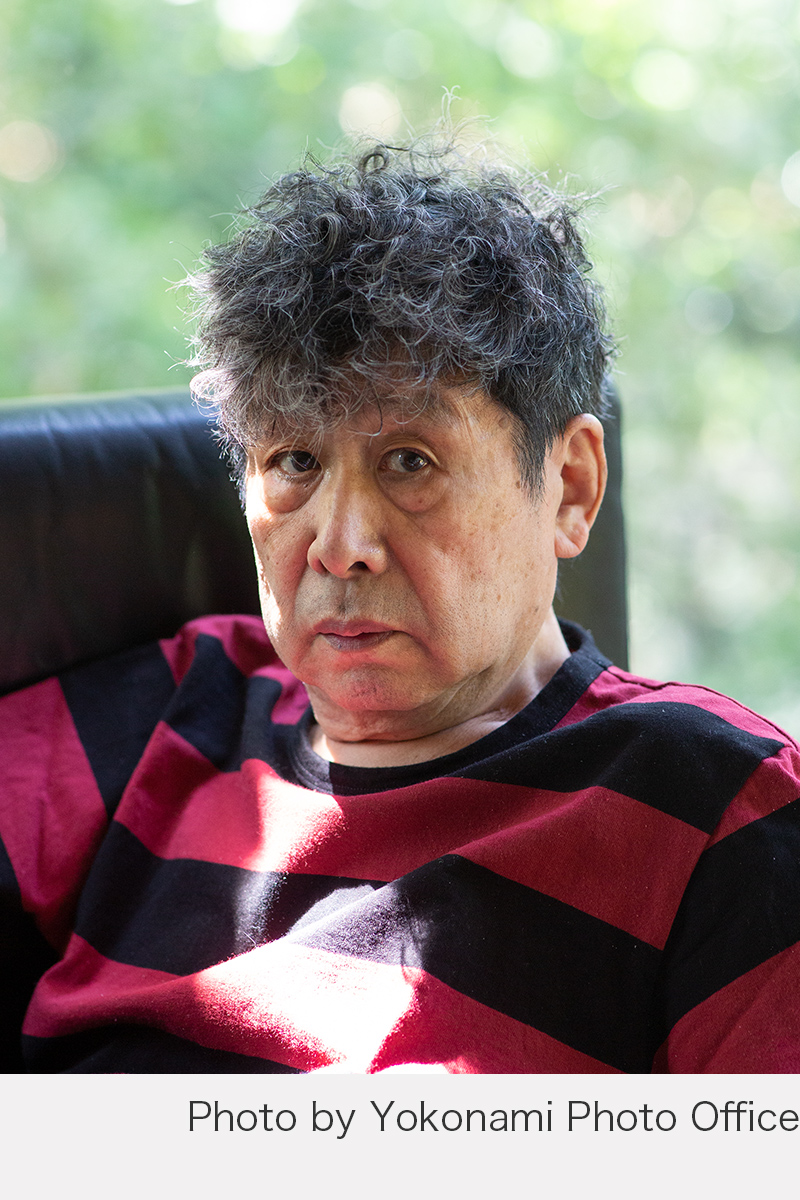
Description
Description
In 1981, Tadanori Yokoo left behind his brilliant achievements and declared his intention to change from designer to artist. At the time, Japan was undergoing a post-war economic recovery and was turning into a consumer society as people's lifestyles became more diverse. Postmodernism became a major topic in the design world, and designs were required to be artistic and differentiated from other products. Tadanori Yokoo's Artist Manifesto was an expression of his own action and exploration of the eternal themes of art versus design and artist versus designer.
In February 2023, we visited Yokoo in his studio for this interview. Yokoo sat on a sofa by a sunny window and handed us a handmade microphone made from a splintered piece of wood and strapped with a rubber band, saying that he was almost unheard. The man did not give us the impression of an artist who continues to produce such powerful works. However, as we began the interview, little by little the image of a powerful expressionist emerged: he had already drawn 100 new works for the exhibition and had finished the draft of his serial column before breakfast. During the interview, I felt that "For Yokoo, creation is as natural as breathing. He doesn't have the slightest desire to do something for someone else or to make society better, he just creates purely for the sake of creation".
Many designers have a place of free expression outside of work that is not controlled by clients. Yokoo, however, turned into an artist without thinking about the future, as Yukio Mishima said, "Yokoo is scary because he has no plan". What can we say about his innovativeness and dynamism!
The unprecedented Yokoo World created by Yokoo has attracted us living in the modern age and has not been able to let go.
Here we spoke to Tadanori Yokoo himself and to Atsuo Yamamoto and Megumi Hirabayashi, curators of the Tadanori Yokoo Museum of Contemporary Art, about the origins of the appeal of Yokoo's world, in addition to his valuable archive of works and documents.
Masterpiece
Master Peace
Design
Poster 'Kyoto Symphony Orchestra', Kyoto Rouken (1962)
Poster 'Peggy Hayama Recital/Kasuga Hachiro singing a love song', Kyoto Rouken (1964)
Poster ‘Tadanori Yokoo’, self-produced (1965)
Poster ‘Koshimaki Osen’, The JokyoTheatre Company (1966)
Poster ‘John Silver’, The Jokyo Theatre Company (1967)
Poster ‘Marie in Furs’, The Tenjo Sajiki (1967)
Poster ‘Shinjuku Thief Diary’, Souzo-sha (1968)
Poster ‘Shin-Abashiri Bangaichi’, Toei (1969)
Pavilion design for Japan World Exposition 'Fibres Pavilion' (1970)
Cover for magazine 'Shonen Magazine', Kodansha (1970)
Record jacket, Santana ‘The Legend of Lotus’, Sony Music Japan International (1974)
Novel illustration, ‘Genka’, Tokyo Shimbun (1974-1975)
Record jacket, Miles Davis 'Agharta', CBS Sony (1974)
Art direction for magazine 'Ryuko Tsushin', Ryuko Tsushin (1980)
Poster, 'Glay', Unlimited Records (1998)
Poster 'Echigo Beer Millenium Beer', Uehara Beer (2000)
Bottle ‘Echigo Beer’, Uehara Beer (2000)
Design for 'JR Kakogawa Line Wrapping Cars', JR West Japan (2004-2011)
Poster 'YOKOO MANIARISM Vol.1', Yokoo Tadanori Museum of Contemporary Art (2016)
Poster 'Yokoo Tadanori: Forest in Soul', Yokoo Tadanori Museum of Contemporary Art (2023)
Art
'Pink Girl' series, (1966- )
'Hot Springs' series, (2005-)
'Y-junction' series, (2000-)
'Kanzan Jittoku' series, (2019-)
Books
"To India" Bungeishunju (1977)
"Kobuna Boy: The Autobiography of Tadanori Yokoo as a Teenager" Bungeishunju (2004)
"The Retirement Manifesto", Heibonsha (2008)
"Tadanori Yokoo Posters", Kokushokankokai (2011)
"Tadanori Yokoo Complete collection of book design", Pai International (2013)
"Leaving Words", Kodansha (2015)
"My way of playing and going: Yokoo Tadanori autobiography), Bungeishunju (2015)
"Tama, Come Home", Kodansha (2020)
"Tadanori Yokoo: Diary of Tadanori Yokoo's Treasure Creation”, Bungeishunju (2020)
"The Forest in Soul", Bungeishunju (2022)
Others
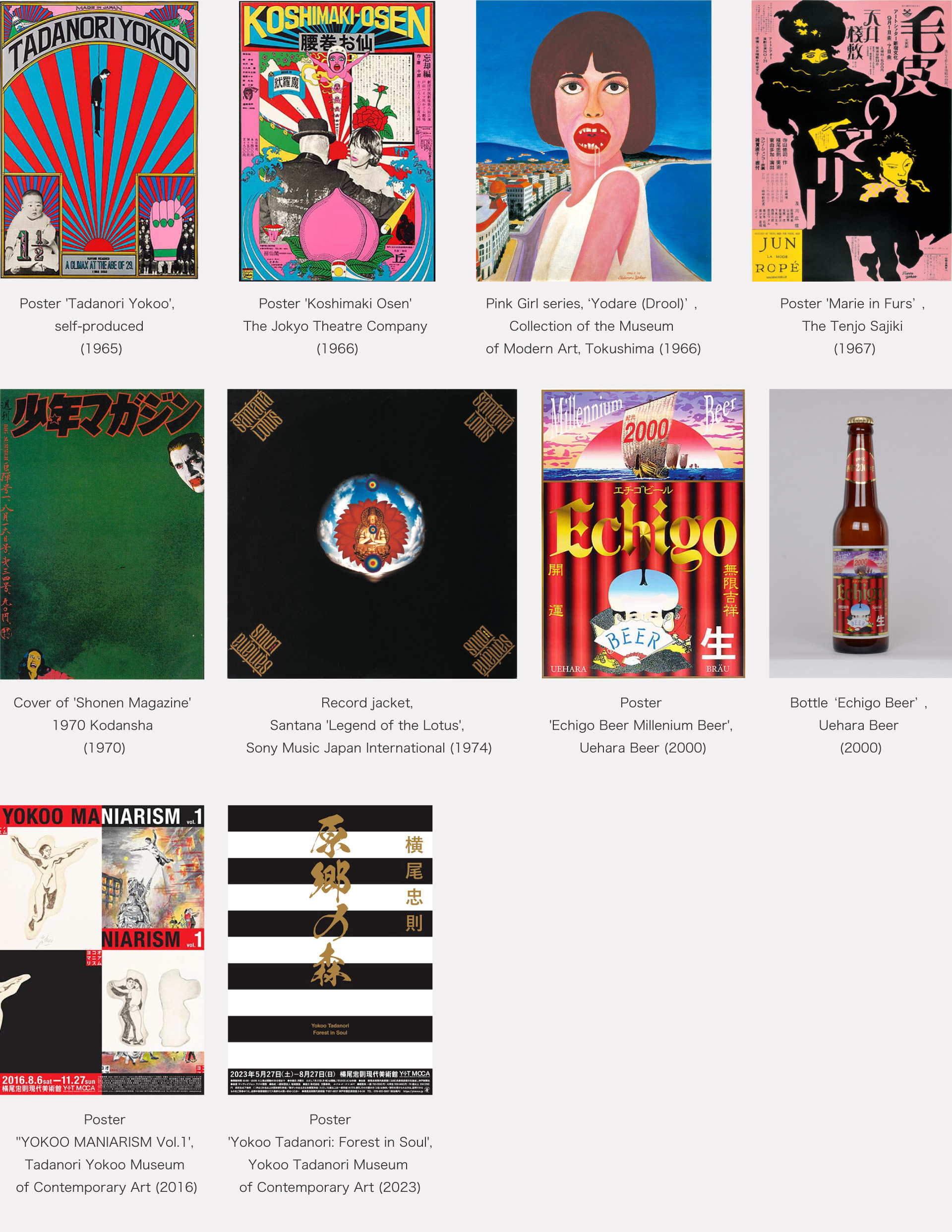
Interview 1
Interview 1
My basic principle is that I enjoy myself.
I'm very sad that the world is running out of fun.
How the Tadanori Yokoo Museum of Contemporary Art was created
ー I would like to ask you about Yokoo's archive. I recently (January 2023) visited the Tadanori Yokoo Museum of Contemporary Art (hereinafter referred to as Y+T MOCA) in Kobe and was surprised by the scale and content of the museum. Could you tell us how the museum was established?
Yokoo I used to store my paintings in Tokyo, but the warehousing costs were very high. I thought it would be cheaper in Hyogo Prefecture, where I am from. So I consulted an acquaintance at an art museum in Kobe and decided to discuss the matter with the Hyogo Prefectural Governor. I visited the then Governor Toshizo Ido, who suggested that instead of looking for a warehouse, you should build an art museum, which would solve the warehouse problem. Of course, I didn't take it seriously at first. However, the project started to take off, and although it took some time, it was decided to donate my artworks and materials in 2011, and the museum was opened in 2012.
ー 「It was a big turnaround. What would you have done with the artworks and materials if the museum had not been built?
Yokoo At the end of the day, I thought that I would just donate them in small pieces to the museums that had held exhibitions for me.
ー That was a wonderful turn of events. Could this have happened by chance alone?
Yokoo I was lucky that I was born and raised in Nishiwaki City, Hyogo Prefecture, that I worked for the Kobe Shimbun when I was young, and that it coincided with the renovation project of the former Hyogo Prefectural Museum of Art (designed by Togo Murano). Either way, the museum project is a kind of politics, and it doesn't seem to be a matter that can be decided at the sole discretion of the governor, so I never thought it would realise.
ー Usually, you can't do it unless the person who wants the museum to be built actively moves to have it built.
Yokoo Really. I never expected that they would take care of everything from the artworks to the materials and maintain an archive. If I wanted to create a museum, I would have to make the move myself. I think Y+T MOCA came about because I didn't take the initiative.
ー The exhibition 'Tadanori Yokoo: A Full Stomach!(Man-Man-Puku-Puku-Man-Puku)’ (hereinafter referred to as Manpuku), which just celebrated its 10th anniversary, was a condensed version of the 30 previous exhibitions - will Yokoo be involved in the planning?
Yokoo Basically, we leave it to the curators. Especially after Corona, I couldn't even go to Kobe. I kept telling them that if they were too serious, they wouldn't be able to put on an interesting exhibition, but recently they have started to play with me and the visitors have been very positive about it. That's why I'm not in charge any more. It is more interesting when the curators take the lead in the management of the exhibition. First of all, If I take the initiative, they have to follow me.
ー Do you make your requests about the maintenance of your own archive?
Yokoo I don't know much about archives, so you should ask the curators directly. But I have already sent many of my works and materials to Y+T MOCA, and when I die, I will donate the things in my studio there. As with the creation of the museum, I have no demands or desires regarding the archive. It has always been like that for everything. If it can be done, it can be done, and if it can't be done, that's fine too. It's strange because people keep pushing me forward. Maybe it is because I am not demanding that they are willing to do so. Because I don't do that, people around me bring me all kinds of stories. This is a kind of law of nature, isn't it?
ー Were you born with these unique qualities?
Yokoo I think it lies in my upbringing. I was adopted by relatives when I was two years old. My adoptive parents, who were already around 50 years old, were like my grandfather and grandmother, and they doted on me. They took very good care of me, they dressed me, fed me and did everything for me. I grew up in such an environment, so perhaps I am still stuck with my infantile nature.
ー -That story is described in detail in your autobiographical book“Kobuna Shonen (Kobuna Boy)”.
Art and design.
ー But isn't it because artists have desires and egos that they are able to engage in expressive activities?
Yokoo Rather than desire, I just create what I want to create. Once the work is completed, I don't care about what happens afterwards. If the museum or the people around me want to do something, they can do it, and I leave it to others. A long time ago, graphic designer Mr Ikko Tanaka once told me, "You have too much of a 'it doesn't matter' mentality, and in Tokyo you can't live unless everything is black and white". Ikko-san must have been giving me advice through his own experience.
Certainly, there are people in the world who go through their ego and resist or assert themselves against something. I think that is their destiny. My destiny was probably set as 'fate' before I was born, so I believe it is easier to let nature take its course. In Ikko's words, it could be said that my way of life has been created by my disposition to say 'I don't give a shit'.
ー Have you been influenced by the various people you've met? Especially from people I met in my 20s, such as Mr Ikko Tanaka, Mr Yusaku Kamekura, Mr Akira Uno, Mr Makoto Wada and Mr Kishin Shinoyama from the design world, Mr Juro Kara and Mr Shuji Terayama from the theatre world, Mr Yukio Mishima and Ms Jakucho Setouchi, Mr Renzaburo Shibata and Mr Mutsuro Takahashi from literature, Mr Ken Takakura and Ms Ruriko Asaoka from acting, foreign artists and musicians, etc., from the top runners of their time.
Yokoo Of course. But I also left my relationships with them to chance. I think we were able to maintain a good relationship with them because we didn't make it black and white.
ー You worked as a graphic designer from the 1960s to the 1970s. Design is subject to various conditions and client demands, and the designer proceeds by clearing each one. Did such a way of designing shift Yokoo's activities from design to art?
Yokoo Design imposes various restrictions and conditions on designer. I can't follow those conditions 100 per cent, but I follow them to a certain extent. If the client sees it and doesn't like it, they come back with a new request. If I am not satisfied with the order, I decline the job. Because I get tired of arguing with them. I am willing to lose the client. I am not cut out for design. I think I have been able to do this because I distanced myself form design at a certain point in my life.
I only worked with people who welcomed my design and art. When I was working as a graphic designer in the early 1960s, I had work-related problems and stress. But when I went freelance, I was free from stress. But many designers think that if they behave like me, they won't get another job, so they compromise to get the job done, and gradually a chain movement of compromise starts and they can't do what they want. If I compromise, I walk away from the job once and for all. As for my life choices, I may have what Ikko calls "made it clear whether to do art or design, to do or not to do".
ー And you still continue to create.
Yokoo Looking back, I have not done much commercial work with companies, including when I was a designer. I worked mostly with theatre companies, people in the film industry, musicians and writers who accepted me. Mr Kara, Mr Terayama and Mr. Mishima would leave me in charge without telling me anything about the details. The theatre people didn't have money, so they were a kind of volunteer, but for me this is healthier for my body and mind.
ー The cultural events that symbolised the 1960s included the rise of underground theatre companies such as Mr Kara's Jokyo Gekijo and Mr Terayama's Tenjosajiki. You were deeply involved with both theatre companies as art director. Your posters in particular are now legendary.
Yokoo They were printed by silkscreen. I later heard from Ms Kyoko Kujo (a founding member of Ceiling Pier, actress) that members of the theatre company put up posters on telephone poles and walls from Shibuya to the Aoyama area, and when they looked around later, they found that they had all been taken off. My posters were useless, she said. But I said back. Someone steals the posters. That's when the theatre begins. That's exactly what theatre is about. That's exactly the kind of theatre they were aiming for. But the fact that the posters were stolen got a lot of media coverage, which was good publicity.
ー Yokoo, your posters from that time are now highly regarded as art.
Yokoo "Koshimaki Osen" and other posters from that period are in museums and private collections. At an auction in the U.S., they are sold for 10 million yen.
In the U.S. and Europe, good posters are regarded as art, not design. Unlike in Japan, good posters are appreciated without stepping on the boundaries of design or art. In Japan, however, the price of a poster is determined by an unspoken understanding that the market price is about this level. In Japan, the price is determined by the average value, not by the quality of the work.
ー Lautrec and Misha were also artists who were recognized for their posters. Today, with the diversification of media such as digital signage, posters no longer have the impact they once did. What do you think of the meaning of the poster as a medium?
Yokoo In the 1960s, before the advent of pop art, I thought that posters on the streets had more social influence than art, and I viewed them as popular art rather than design. Even today, in cities like Paris, posters are recognized as art in the city, and there are places where they can be hung. In Japan, on the other hand, the only places where posters can be hung are in train stations. It is true that posters in Japan have become so commercialized that it is difficult to evaluate them as art. That is partly the fault of the corporations, but it is also the fault of the artists and designers. If designers are at the mercy of corporations and clients, posters will decline and will lose their independence. What is most important is to create good artwork.
ー Is there anything that can be done about this situation? Do you have any good ideas?
Yokoo I didn't resist or try hard from the front, but I did implement something interesting from a different perspective.
In 1971, I was asked by Tokyu Department Store in Shibuya to do a poster advertising their Christmas sale. I designed several different posters called "Christmas Paradise," inspired by the image of Tahiti, with the idea of "midsummer in the middle of winter," and told them to put up different posters on each floor. I also suggested that the posters be displayed in the Shibuya subway. The idea was that my posters would hijack the whole Shibuya area.
However, I was told that some of the posters were designed with nude photos and could not be displayed in public stations. I gave the station attendants black magic markers and asked them to fill in the areas that bothered me. The station attendant painted over the boobs and buttocks in my poster. As a result, my poster was transformed into a unique poster. As a kind of performing art, it became a big topic of conversation and publicity. It was a great publicity opportunity.
ー You enjoy it yourself, don't you?
Yokoo That's right. You can make it as interesting as you want, depending on your ideas. My basic idea is to enjoy myself. However, nowadays, the fun is being lost more and more. There are fewer and fewer clients who are willing to have fun, and fewer and fewer designers who are willing to have fun. I wonder where the maverick people have gone. The world has lost its sense of fun, and I feel sad about it.
Outside of knowledge, culture, and intellect.
ー It is a well-known story that You were reborn from a designer to an artist after seeing the "Pablo Picasso: A Retrospective" exhibition at the Museum of Modern Art in New York in 1980. Picasso tried his hand at a variety of expressions in his lifetime, including painting, ceramics, and sculpture. What about you, Yokoo?
Yokoo I do what I am asked to do. I have done stage design, restaurant design, and even designed the pavilion at the Osaka World Exposition. But I don't think of doing more once I have finished those projects, but when I finish one work. But strangely enough, it's a chain of projects. I just don't go against the flow.
Maybe it's because I'm so passive that the people around me feel they have to do something for me. I made theatre posters because Mr Terayama and Mr Kara asked me to, did stage design for La Scala in Milan at the request of Maurice Béjart, and became an actor at the request of film director Mr Nagisa Oshima. From there, new stories started coming in. But if I don't like it, I don't do it, no matter how good the offer is. I'm not very fit, so I can't protect my health otherwise. When I see people who are overworking themselves, I wish they would just take it easy and leave it alone.
ー In reading your book, you had many accidents and illnesses, and had been hospitalised for long periods of time. Through such experiences, did you come to go back and forth between the spiritual world and other dimensional worlds, which are different from the real world?
Yokoo Such a world has its own system, and on the other hand, there is the system of the present world in which people live. It is rather hard to get on the system of this world, and I have been careful not to do so.
ー I heard that Yokoo has recently suffered from hearing loss and a serious illness. I think this has made you physically, in other words, less able in this life than you used to be. Have these changes affected your creative motivation and the subjects and methods of your expression?
Yokoo As I get older, my handicaps increase. Now I have tendonitis, my hands hurt and I have difficulty seeing. Then I think I should paint pictures that don't defy my handicap. For example, I can no longer draw straight lines, but that is my expression now. If that is the natural state of things, I just go with it. I don't resist in vain, so the work keeps changing. Even if the expression of my work is weaker than before, I think it's fine to leave it as it is because that's my individuality now.
ー Your latest series, 'Kanzan Jittoku', breaks new ground in terms of fuzzy expression. Come to think of it, Monet, famous for his 'Water Lilies', also changed his paintings after his eyesight failed in his later years. But his reputation and value have not declined.
Yokoo That's right. In fact, Monet's paintings in his later years are regarded as the sunrise of abstract expression. It is interesting to note that Monet's handicap conversely made him a pioneer of abstract art.
ー We have heard that you have completed 100 pieces of work, 'Kanzan Hyakutoku', for an exhibition at the Tokyo National Museum (hereafter referred to as 'Tōhaku') this autumn. What was the background to your choice of the theme 'Kanzan Jittoku'?
Yokoo Two years ago, there was an exhibition at the National Art Centre, Tokyo called 'Classics x Contemporary 2020, Japanese Art Transcending Time and Space', in which eight contemporary artists created new expressions in response to masterpieces from the past. The museum gave me the theme of ShoHaku, a painter active in the mid-Edo period. So I decided to create a new work in homage to his most famous work, 'Kanzan Jittoku'
Even if I am given a theme, how I sublimate it depends on my ego. I thought that I could depict the 'Kanzan Jittoku' in any way I wanted to. After all, they are masters of play. In the end, I myself became a ‘Kanzan Jittoku’(laughs). I took this opportunity to start painting on the theme of 'Kanzan Jittoku', and in 2021 I exhibited it at the exhibition 'GENKYO Yokoo Tadanori' at the Museum of Contemporary Art Tokyo.
A curator at Tohaku saw the painting and came up with the idea of an exhibition that combined my painting with the ‘Kanzan Jittoku’ in the museum's collection. The story is simple.
ー The two paintings near the door of your studio are the ‘Kanzan Hyakutoku’ for Tohaku? Your style seems to have changed considerably from previous works.
Yokoo All the expressions in the new paintings are different. I have those two works on hand because I still want to make changes to them. ‘Kanzan Jittoku’ were a slightly strange Zen monks from the Tang dynasty, so I painted them freely.
ー I think people will be talking a lot about how your style has changed again, how you've broken new ground.
Yokoo Ha ha ha (laughs). I don't want them to, but I'm sure the art world will see it that way.
ー The combination of Tohaku and Yokoo is groundbreaking.
Yokoo It's unique that Tohaku, which has collected the best of traditional Japanese art, approached me, and it's the first time they've held an exhibition of contemporary artist.
ー Yokoo's works have always been said to be attractive because it crosses the boundaries between the classical and the contemporary, art and design, the sublime and the vulgar. Perhaps that is why.。
Yokoo It's not so much a boundary as an 'in-between'. The grey between black and white, or the ambiguity or indecision between the two. It's a way of life where you can live either way, and that's what the picture is about. Freedom is a bit different. Most people set a certain 'frame' and try to be free within it, but I don't even have a frame to begin with, so I can do whatever I want. I make use of my character of being bored and not being able to keep doing the same thing. I have no ideology from the beginning.
ー But didn't you participate in the demonstrations against the Security Treaty in the 1960s when you were at Nippon Design Center?
Yokoo Yes, I was inspired by the World Design Conference held in Tokyo just in 1960, and I marched along Ginza Street with placards, thinking that "designers must also be involved in social issues and must have ideas. Even in the midst of all this, I felt as if I was somehow a stranger to the world.
ー When I read Yokoo's book and the Asahi Shimbun's review of it, I cannot believe that it is the writing of someone who is indecisive and has no ideology. What is this discrepancy?
Yokoo I am not sure. First of all, I don't read many books; I hardly read any books until I was over 40. But by not reading books, I was on the outside of knowledge, culture, and intellect. But there is a bigger, wider world outside. I think that knowledge, culture, and thought unconsciously form a "category" surrounded by a "frame," and that we can only think and act within that frame. I think I have never been bound by "frames" or "categories," but have always been on the outside of them.
ー I am amazed at the vividness of your writing and your memory. Do you keep a daily record in a diary or sketches?
Yokoo I write diaries and blogs, but I don't use them as a reference. I don't remember things by memory, but by my physical body. It is different from memory. Memory is about intellect and education, or reading, listening to, or memorizing what others have experienced, but in my case, my body remembers. It is different from memory in my head.
ー but it is too rich for something that comes from the body.
Yokoo That is, for example, a child may say something that strikes the essence of a thing that would make an adult gasp. This is because children do not know a lot of words and try to say things with only a few words, so they are able to strike at the essence of things. However, adults have acquired a lot of knowledge and words, so they think about unnecessary things. Children use their intuition and feelings. If they find my writing interesting, it is because I write with the sense of a child.
ー The diary was on display at the "Manpuku" exhibition.
Yokoo I don't usually carry a notebook or sketchbook, but I do take my diary with me. I do write collages and simple notes in the empty spaces in my diary, but that is not for any purpose. I do it because I enjoy writing and sketching in the diary itself. I have no desire to make use of it for something in the future. It would become uninteresting if it had a purpose in that way.
ー However, planning and strategy take precedence over everything else in the modern era, though.
Yokoo I see. People who think that way must be anxious if they don't think about the future and make plans to move forward. I rarely think about the future. I only think that I will probably die in the future. But what is produced may differ between those who think about the future and those who do not think about the future. This is something I cannot control.
ー I can see that the writer Yukio Mishima, with whom you were close, was a man who, in contrast to Yokoo, planned and carried out his projects with a tight schedule. How did you two get along?
Yokoo Mr Mishima is the one who planned everything and made everything black and white, even his death. When he went on his first trip abroad, and he planned and executed a minute-by-minute schedule in Japan. I, on the other hand, think that travel is fun because it is unplanned. He told me, "You are always unplanned, which is scary. Mr Mishima was a man of intelligence and culture. In that sense, we are really in contrast. Then he also told me, "Yokoo, you are an après-guerre. But he was probably the one who admired " après-guerre," but he was too smart to do so.
ー Mr Mishima may have been attracted by the magnetic force that Yokoo, who is the complete opposite, radiates, and he may have admired your freedom. Finally, could you tell us about your daily routine?
Yokoo I wake up at 6:30 to 7:00 and write a little essay before breakfast at 8:00. I think I wrote about six pages today. I am currently working on a series of articles for a town magazine called "Kobe-kko”.
Sometimes I keep floundering about painting, and sometimes I spend days doing nothing. Recently, more and more people I know have passed away. I don't want to live too long either. I think I will keep painting as long as I live, but I am already bored. I don't want to live that long, but that wish may kill me. But I feel that Mr Mishima is telling Yokoo to stay in this world longer.
ー Thank you very much for your time today, and I look forward to many more solo exhibitions in 2023.
Interview 2
Interview 2
Date: March 16, 2023, 13:30-15:30
Location: Yokoo Tadanori Museum of Contemporary Art
Interviewee: Atsuo Yamamoto, Megumi Hirabayashi
Interviewer: Yasuko Seki
Author: Yasuko Seki
Tadanori Yokoo's archive now and in the future
Tadanori Yokoo Archive
ー Today we would like to ask you about the "Tadanori Yokoo Archive. First of all, we would like to ask how the Yokoo Tadanori Museum of Contemporary Art (hereinafter referred to as Y+T MOCA) was opened.
Yamamoto Y+T MOCA opened in November 2012, but the idea had been in the works for five or six years prior to that. Mr Yokoo had visited Hyogo Prefecture frequently to design the wrapping train for the JR Kakogawa Line in 2004 and to prepare for the "Tadanori Yokoo, King of Adventure" exhibition that traveled to the Hyogo Prefectural Museum of Art in 2008, and he asked the curator of the museum if there was a suitable warehouse in his home prefecture of Hyogo. The idea was then to talk directly to the governor, which led to a meeting between Mr Yokoo and then Governor Mr Toshizo Ido. Mr.Ido offered the idea of building an art museum. Officials from various related organizations were also present, and I think they were all surprised by the sudden statement, but they decided to explore the possibility of accepting the Governor's offer.
However, since the prefecture was in the midst of a financial restructuring, it was difficult to construct a new art museum, and it took longer than expected to reuse existing buildings and secure a budget. For these reasons, the current Y+T MOCA occupies the west wing of a building designed by Mr Togo Murano, which was a major renovation of the former Hyogo Prefectural Museum of Modern Art. The building has four floors above ground and one below, and currently uses the first floor as an open studio, the second and third floors as exhibition rooms, the fourth floor as an archive room and gallery, and the basement as storage for artworks.
ー Have you been involved in the project from the initial stages?
Yamamoto I have been involved since 2011. I was originally a curator at the Museum of Modern Art, Shiga, but Mr Yokoo, who was frustrated with the lack of progress in the project, insisted that I bring in someone who understood art. I was approached by my former boss at the Hyogo Prefectural Museum of Art, and then I decided to take part in this project. The Y+T MOCA was finally able to open its doors after solving many problems since then.
The project started with a single voice from the governor, but I do not think that Mr Yokoo and the prefectural side were necessarily facing the same direction. He must have been anxious after waiting so long.
ー What is the total number of works in the current collection?
Yamamoto As of March 2022, we have 173 paintings, 214 prints, 1,365 posters, 3 originals and drawings, 75 photographs, and 40 other works, for a total of 1,870 items in our collection. In addition to these, there are about 900 works on deposit. In addition, we have received more than 700 boxes of materials from Yokoo's side for our archives, but we are in the process of organizing them one by one, so the total number is not yet known.
ー The website has a section called "Archive," where you can see the data that has already been organized. Please tell us about the archiving process.
Yamamoto Most of the materials from Yokoo are sent to us in cardboard boxes. The contents are roughly categorized by age and theme, but we prioritize and organize them according to our own rules. In principle, the organized materials are divided into five categories: manuscripts, bindings, published journals, catalogs, and others. Specific work is carried out in accordance with the budget, personnel, and other circumstances, and is centered on 1) overview research and manuscript records, 2) content research, 3) structural analysis, and 4) multi-purpose use.
In addition, with dedicated archive staff, we are proceeding with the following procedures: 1) survey of current status, 2) classification and sorting, 3) registration and temporary preservation treatment, 4) main photography and database, 5) preparation of records, and 6) preservation treatment of the materials. Materials sent by Yokoo are classified as "archival materials," while those purchased or received independently by the museum are classified as "library materials.
ー What is the organization of Y+T MOCA?
Yamamoto Y+T MOCA has three full-time curators, and one each in charge of archiving, restoration, and education on a contract basis, for a total of six people (from 2023, the number of contract staff will be reduced by one to five). The archivist makes the basic plan and instructs us, the curators, on when and how to proceed with the archiving work. We follow her instructions as much as possible.
Hirabayashi In the beginning, we were aiming for perfection in each task, but there were too many processes and it was difficult to get things done. We prioritised "understanding the whole picture" to streamline and streamline our work. Currently, we are prioritising textual data rather than photographic data.
Yamamoto We have a limited budget, time, and manpower, so we are trying to choose the best way to link the works and materials with the text (information).
ー I see that the website allows anyone to search the list of works from the "List of Organized Archival Materials". Could you briefly tell us about the structure of the database?
Yamamoto We use FileMaker Pro for the data. Each file (or box) containing materials is numbered with a four-digit outline catalogue (box number), and its contents are numbered with a four-digit contents catalogue (branch number), each of which is an eight-digit control number. The title, date, and other information are then written on it.
Hirabayashi In many cases, the sorting process is combined with preparations for an exhibition, and in such cases, we compile in-depth data on the dimensions, materials, condition, and whether or not restoration is necessary.
ー How about the management and operation of the archive room?
Yamamoto The archive room is maintained at 22 degrees Celsius and 55% humidity throughout the year, with basic conditions such as lighting fixtures that do not emit harmful light, and air environment measurements using air samplers and passive indicators are taken on a regular basis. We also take all possible measures against earthquakes, such as securing shelves as well as wrapping stored items with bleached fabric to prevent them from falling. All artworks except for those in the archives are stored in the storage room on the basement floor.
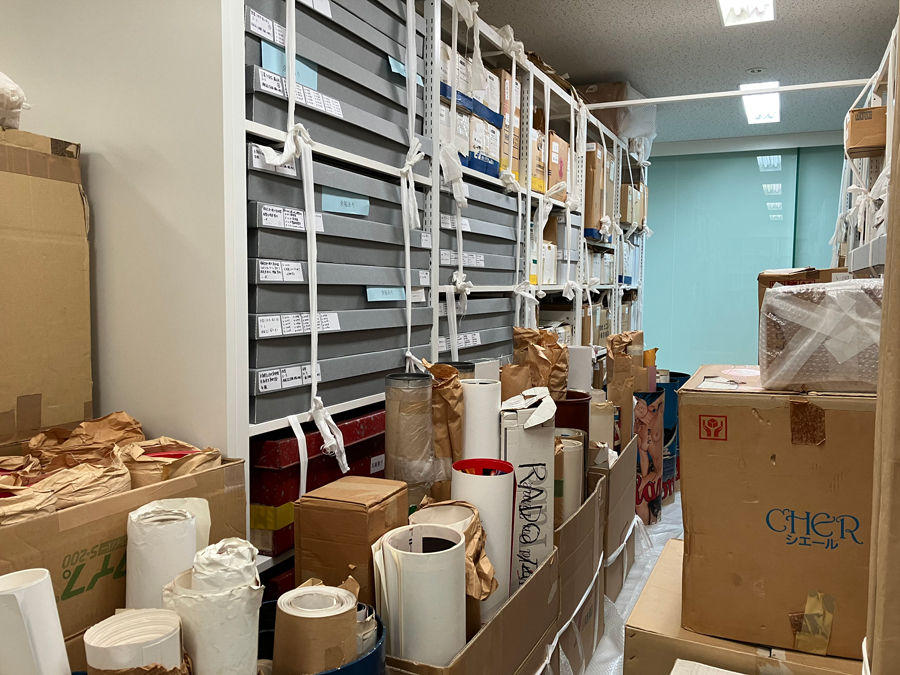
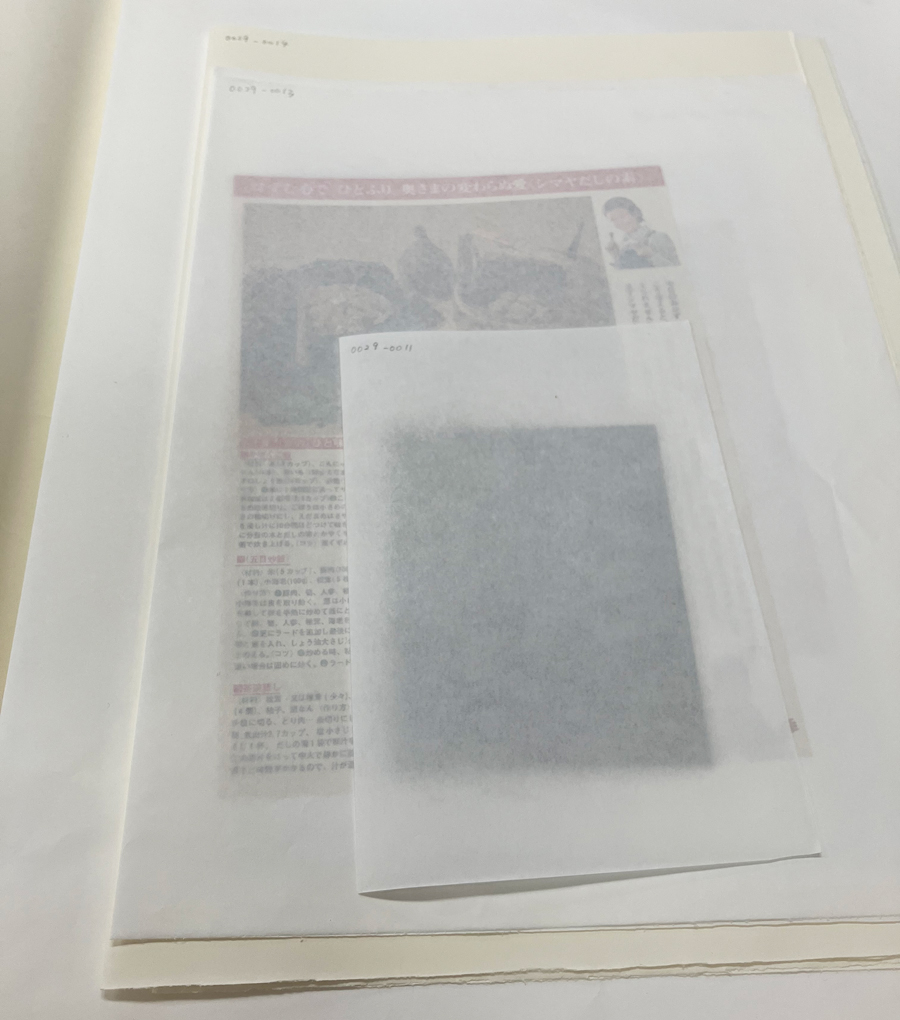
A vast number of sketches and documents, including unorganised material, are managed in the archive room (left).
The data maintenance of the vast number of works and documents is ongoing (right).
Y+T MOCA's unique exhibitions
ー Y+T MOCA also holds innovative exhibitions. How is Mr Yokoo involved in these exhibitions?
Yamamoto When the museum first opened, we received a fax from Mr Yokoo. It contained a list of 51 or so exhibition plans that he had come up with, but only the titles. We would plan them as we imagined what he might want to do.
ー I heard that museums usually take about three years to prepare for a single project.
Yamamoto Certainly, but the Y+T MOCA takes about one year. Every year around the end of the Golden Week holidays, three curators put together a plan for the next year's exhibition and discuss it with Mr Yokoo, and once the direction is set, the plan takes shape. We have a large collection of artworks and materials, but we are also involved in catalog production and publicity activities, so we are always on a last-minute schedule.
Hirabayashi We need to lend Yokoo's works to other museums and reflect Yokoo's ideas, so it is better to concentrate on the project in a short period of time. Also, recently we have developed a relationship of trust between Mr Yokoo and ourselves, so he trusts us more than before.
ー What was the catalyst for building a relationship of trust?
Yamamoto In 2021, the Museum of Contemporary Art Tokyo held the largest-ever exhibition 'GENKYO Tadanori Yokoo'. We lent out about 200 works from the main museum, so the storeroom was empty. But we had to put on a special exhibition. Ms Hirabayashi organised an exhibition called 'Curators in Panic'. As a bitter pill, three curators selected works remaining in the storeroom and exhibited them with comments. It was like, 'There are cute kids among the leftovers'. We had been trying to avoid showing the individuality of the curators, but we decided that this was possible.
The next exhibition, ‘Tadanori Yokoo's Haunted House’, also turned the entire museum into a haunted house and selected grotesque works from the few remaining pieces to be exhibited, which resulted in the second highest number of visitors since the museum opened. Neither of these were seen by Mr Yokoo due to the Corona Vortex, but the reputation of the exhibition caught his ear and he felt that we are doing a good job. A project that stood in a tight spot unexpectedly turned out to be a success.
ー When we interviewed Mr Yokoo, he said, "The latest projects have a 'playful' feel to them".
Yamamoto I'm glad to hear that. In the beginning, we were nervous because we were working with that Tadanori Yokoo, and there was a part of us that thought we had to give shape to Yokoo's ideas. But recently, I feel that he finally trusts us.
ー There are several exhibitions that would never be possible in other museums.
Yamamoto In 2013, shortly after the museum opened, the 'YOKOO's YOKOO ZOO' exhibition was held, and the 'Welcome to Yokoo Hot Spring Village!' exhibition in 2016 were projects that only our museum could have organised, and they also attracted a lot of attention. In the former, in collaboration with the Kobe Oji Zoo, we borrowed stuffed animals and combined them with Yokoo's works. The latter was a transformation of the museum into a hot spring inn, with the cooperation of the Kinosaki Onsen Ryokan Association in Hyogo Prefecture. At this time, Yokoo told us that soft-serve ice cream was essential for a hot spring, so we borrowed a soft-serve ice cream-shaped object and exhibited it. That became a big topic of conversation on Instagram. Yokoo's ideas are happening and we are having a lot of fun with them.
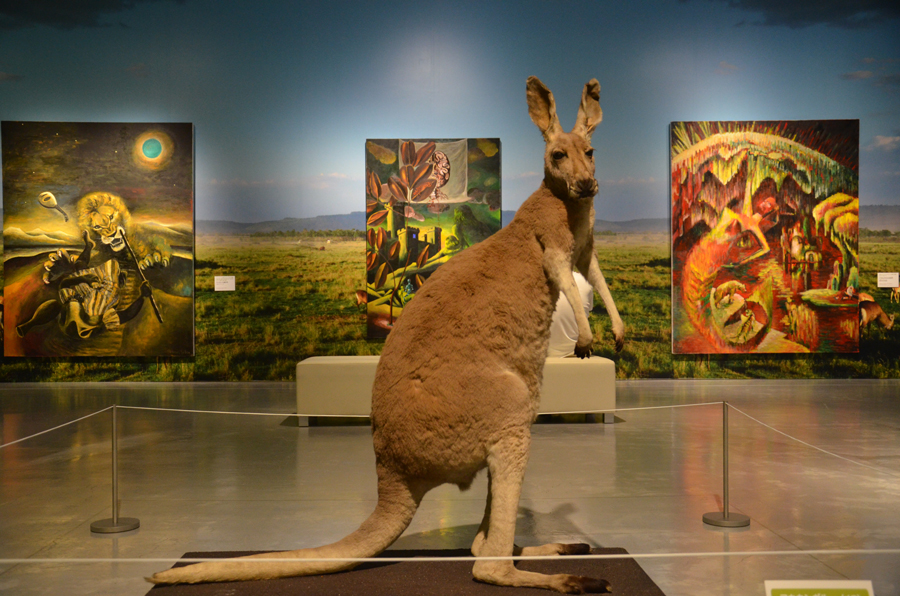
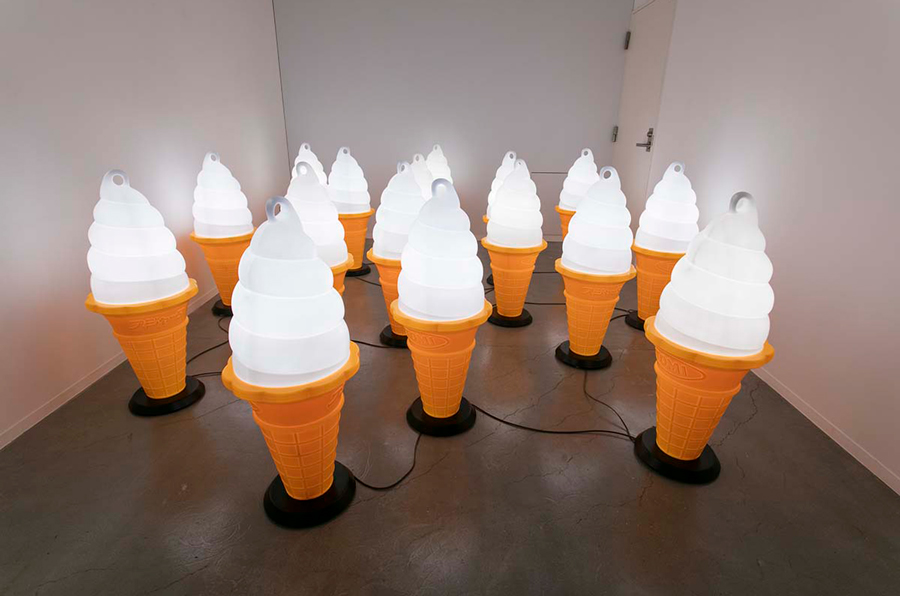
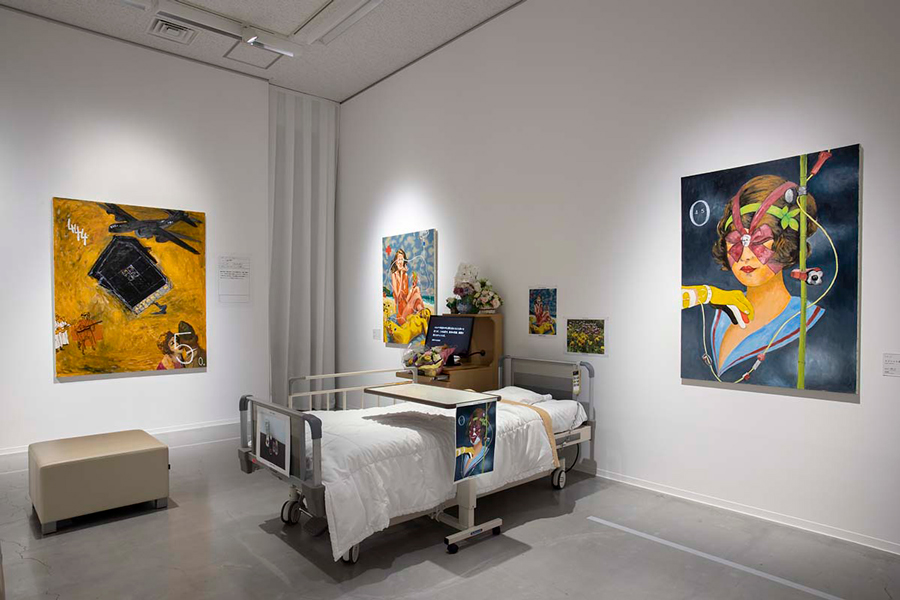
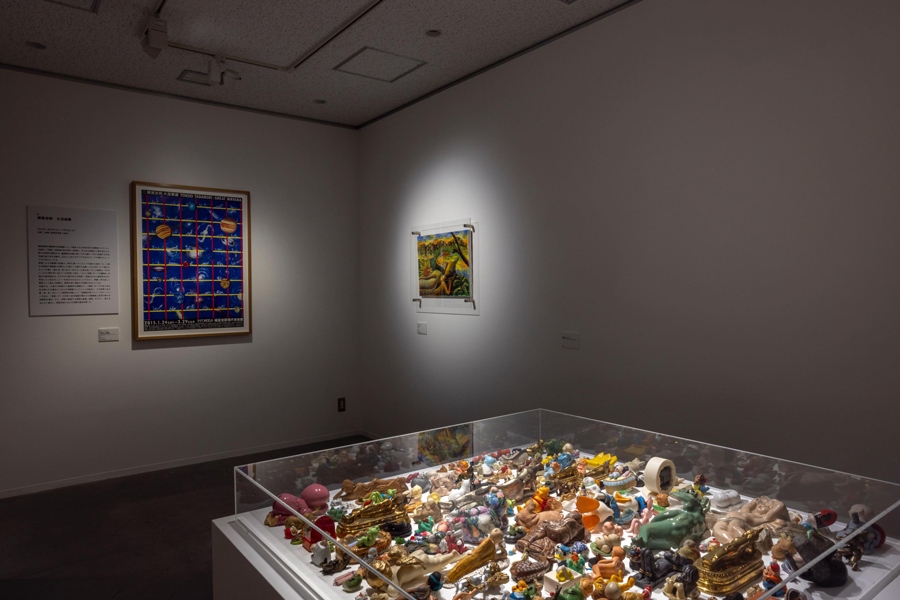
The "Yokoo Animals: YOKOO'S YOKOO ZOO" exhibition, the "Welcome Yokoo Hot Springs Village!' exhibition, the 'Prefectural Yokoo Emergency Hospital' exhibition and the ‘Yokoo Tadanori: A Full Stomach!' exhibition's nirvana statues - these unexpected exhibitions are full of originality and embody Yokoo's world view.
ー Since its opening in 2012, the museum has organised a truly diverse range of exhibitions. It can be said that this is the result of the size and depth of the world view of Yokoo's works.
Yamamoto Unique projects such as a spa, a zoo and a haunted house would never be possible for a minimalist contemporary artist, but Mr Yokoo is OK. This is because the world of Yokoo's work is infinite, from the sublime to the mundane, and the number of works is large and varied.
Hirabayashi The range of Yokoo's works is really large. The subjects of his paintings are of course diverse, but a thick collection of his prints alone could be made, and his illustrations for newspapers and books are also very fine works. In this sense, we are opening the vast drawers of the artist Tadanori Yokoo one after another to find material for unique exhibitions.
ー The two diaries on display at this year's 'Manpuku' were a sight to behold.
Hirabayashi We have diaries from 1981 to 2014. The diaries are also diverse in their expression: when we organised an exhibition focusing on archival materials called 'YOKOO MANIARISM vol. 1' in 2016, we not only exhibited artworks and materials, but also allowed visitors to watch live footage of the organising process by curators in the exhibition room. It made us realise the potential of the archive.
Future
ー What are your future plans for the museum?
Yamamoto The theme of our special exhibitions is limitless. We have a large collection of posters and other graphics, prints and works from the 1980s and early 1990s, but until now we have not been able to organise exhibitions focusing on these. I would also like to shed light on the use of the archive in consultation with Mr Yokoo.
Hirabayashi Recently, exhibitions focusing on the 1980s have been held overseas. This was the period when Mr Yokoo turned into a painter, and as there are works and materials that have not yet been exhibited, we would like to further our research and create a place for them to be shown to the public.
ー 'Tadanori Yokoo' is a very big name. I am interested in how you actually communicate with each other.
Yamamoto He is a multi-talented artist who draws and writes, and is truly a work of art in his own right. And even now, at the age of 86, he continues to be in the spotlight. We don't want to do anything that would put a damper on his drama. However, in order to realise a project, we cannot avoid practical issues such as lack of budget or schedule difficulties. We try to consult with them with careful consideration.
Hirabayashi He has published many books and has an amazing memory for events, probably because he checks his own texts repeatedly on a daily basis. We sometimes discover new facts when we ask him to check the texts in our catalogue.
ー Y+T MOCA may not be blurred as a museum because of the overwhelming presence of Mr. Yokoo.
Hirabayashi He is the subject of research for all of us, and his presence is so great that there is a sense of solidarity among the curators in a good way. It's not a time for cliques (laughs).
Yamamoto There are times when I feel like quitting because of his reckless demands (laughs), but looking back over the past 10 years, I think it has been a very intense time. It's a special environment to dig deep into Mr Yokoo, but I realise that I've gained valuable experience because of that.
Hirabayashi Indeed, it is a special museum, but I think it is interesting for those who want to pursue a single theme or artist, including the archive. The range of Yokoo's works are also wide. The archive material includes underground theatre from the Showa period, music and design from the 60s and 70s, work that evokes the culture of the 80s and 90s Furthermore, there is a wide variety of records of friendships with people who were part of the culture of that era, and wherever you enter, there is an expanse that takes you to a world we do not know.
ー The exhibition poster was also designed by Mr Yokoo, and I enjoyed watching the video of the gallery talk.
Hirabayashi We couldn't hold events or workshops at the Corona Disaster, so we made an explanatory video instead, but thanks to you, we were able to record the exhibition on film.
Yamamoto We are still in the process of developing the archive, so we will continue to work on it diligently.
ー Thank you very much for your valuable talk today, including the tour of the archive room.
Location of Tadanori Yokoo's archive.
Contact
Tadanori Yokoo Museum of Contemporary Art
https://ytmoca.jp/

